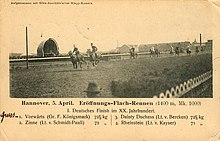Target photo


A photo finish is used in many sports made to the running order and the running times of the athletes in the target document beyond doubt. A finish where the order of arrival can only be determined by evaluating the finish photo is called a photo finish .
The classic type of target photo generation uses a photo camera in which the film is moved behind a fixed focal plane shutter at a suitable speed. The lens and slot are precisely aligned with the target line , which means that only this area is exposed at different times. The disadvantage of this method is that the film development takes a long time and therefore the race result is not available immediately.
Later, the target photo was mostly taken with a video camera and video recorder , which had to record at least 100 images per second . The most common method currently used at important events is a digital photo-finish camera that films the finish line and creates a target photo strip on the computer . Modern cameras can record a few thousand lines per second, which are then put together to form a target photo.
Digital photo-finish cameras
With the digital photo-finish cameras, you only see the finish line on the finish photo, as the camera films the full height of the picture vertically, but only records one pixel horizontally and all pictures are lined up horizontally one behind the other. Everything that moves quickly by in front of the camera looks as usual, what moves slowly by looks distorted in width. Ski rhizomes or skull or belt when rowing act then curved rather than straight as you would expect.
Since the pixels are placed one behind the other by the camera, it doesn't matter in which direction the person or object is moving.
commitment
Digital photo-finish cameras are the most widely used because they are precise, easy to use, and reliable. Time resolutions in the range from 1 / 2,500 s to 1 / 10,000 s are partially supported. High resolutions are required, for example, in canoe racing , where time information should usually be accurate to a thousandth of a second and the necessary security during the measurement should be given.
Ensuring correct timing
The orientation of the camera plays a big role. Slight deviations from the finish line can lead to incorrect results. Alignment is particularly complicated because the camera must not be tilted to the left or right (incorrect measurement points) or rotated (incorrect target approach display). Furthermore, the camera must be set up at a sufficient angle with which all necessary details can be seen without overlapping being able to prevent an evaluation. It must also be ensured that the image sharpness is roughly the same for all lanes. Susceptibility to wind and shock must also be ruled out. In athletics competitions, in some cases for these reasons, the camera is often only mounted just below the stadium roof .
If not only the time intervals are decisive for the competition , but also the end times (which is usually the case), the camera must be coupled with the start signal . This can be done on the one hand by hardware solutions or in complex time measurement systems through exact synchronization of the time bases involved (camera clock, competition clock, etc.). In athletics , for example, the starting pistol is fired precisely at the finish line for control purposes. In this process, known as the zero test or zero point check, the muzzle flash can be seen on the image generated. The time measurement must begin with a maximum delay of one thousandth of a second. This ensures correct synchronization.
Often it is in the target amount, the target line, a rotating relative to the camera drum set. This is used for function control: If its cycle time is constant (for example one second ) and the camera is set correctly, the printed lettering (often advertising for the manufacturer of the time measurement technology) is displayed correctly in the recording and this must be exactly according to the cycle time on the time axis start all over again.
The use of a backup system - i.e. a second target photo device - is usually required for important competitions . If the sport permits, the cameras are set up opposite each other at the finish. This also reduces the risk that the evaluation of the recordings becomes impossible due to overlapping of the participants .
Use in sports
In principle, the finish photo is used in all types of sports in which one finds tight finish lines and thus hardly any manually measurable time intervals. These include: athletics , swimming , cycling , biathlon , rowing , canoe racing , but also dog or horse races .


